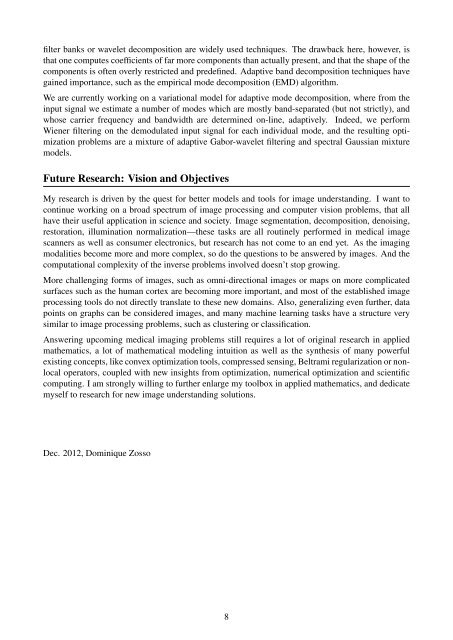Research statement - UCLA Department of Mathematics
Research statement - UCLA Department of Mathematics
Research statement - UCLA Department of Mathematics
You also want an ePaper? Increase the reach of your titles
YUMPU automatically turns print PDFs into web optimized ePapers that Google loves.
filter banks or wavelet decomposition are widely used techniques. The drawback here, however, is<br />
that one computes coefficients <strong>of</strong> far more components than actually present, and that the shape <strong>of</strong> the<br />
components is <strong>of</strong>ten overly restricted and predefined. Adaptive band decomposition techniques have<br />
gained importance, such as the empirical mode decomposition (EMD) algorithm.<br />
We are currently working on a variational model for adaptive mode decomposition, where from the<br />
input signal we estimate a number <strong>of</strong> modes which are mostly band-separated (but not strictly), and<br />
whose carrier frequency and bandwidth are determined on-line, adaptively. Indeed, we perform<br />
Wiener filtering on the demodulated input signal for each individual mode, and the resulting optimization<br />
problems are a mixture <strong>of</strong> adaptive Gabor-wavelet filtering and spectral Gaussian mixture<br />
models.<br />
Future <strong>Research</strong>: Vision and Objectives<br />
My research is driven by the quest for better models and tools for image understanding. I want to<br />
continue working on a broad spectrum <strong>of</strong> image processing and computer vision problems, that all<br />
have their useful application in science and society. Image segmentation, decomposition, denoising,<br />
restoration, illumination normalization—these tasks are all routinely performed in medical image<br />
scanners as well as consumer electronics, but research has not come to an end yet. As the imaging<br />
modalities become more and more complex, so do the questions to be answered by images. And the<br />
computational complexity <strong>of</strong> the inverse problems involved doesn’t stop growing.<br />
More challenging forms <strong>of</strong> images, such as omni-directional images or maps on more complicated<br />
surfaces such as the human cortex are becoming more important, and most <strong>of</strong> the established image<br />
processing tools do not directly translate to these new domains. Also, generalizing even further, data<br />
points on graphs can be considered images, and many machine learning tasks have a structure very<br />
similar to image processing problems, such as clustering or classification.<br />
Answering upcoming medical imaging problems still requires a lot <strong>of</strong> original research in applied<br />
mathematics, a lot <strong>of</strong> mathematical modeling intuition as well as the synthesis <strong>of</strong> many powerful<br />
existing concepts, like convex optimization tools, compressed sensing, Beltrami regularization or nonlocal<br />
operators, coupled with new insights from optimization, numerical optimization and scientific<br />
computing. I am strongly willing to further enlarge my toolbox in applied mathematics, and dedicate<br />
myself to research for new image understanding solutions.<br />
Dec. 2012, Dominique Zosso<br />
8
















